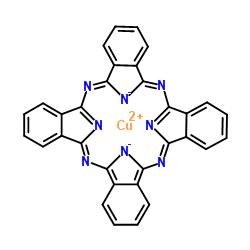Colloidal dispersion stability of CuPc aqueous dispersions and comparisons to predictions of the DLVO theory for spheres and parallel face-to-face cubes.
Jiannan Dong, David S Corti, Elias I Franses, Yan Zhao, Hou T Ng, Eric Hanson
Index: Langmuir 26(10) , 6995-7006, (2010)
Full Text: HTML
Abstract
The dispersion stability and the zeta potentials of nonspherical crystalline (beta-form) copper phthalocyanine (CuPc) particles of hydrodynamic diameter d(h) approximately = 90 nm were investigated at 25 degrees C in water and in aqueous solutions of NaNO(3). The electrolyte concentrations c ranged from 1 to 500 mM and the particle concentrations ranged from 50 to 10,000 ppm (0.005 to 1 wt %). In each case, the Fuchs-Smoluchowski stability ratio W was determined from dynamic light scattering (DLS) data and the Rayleigh-Debye-Gans (RDG) scattering theory. The data suggest that electrostatic effects play a major role in the stability of CuPc-based dispersions. The calculated particle charge z per CuPc particle based on the zeta potential data and the area of the particles (assumed to be cubical) suggests that there is preferential adsorption of NO(3)(-) ions on the uncharged CuPc surface, and the surface charge increases with increasing electrolyte concentration. Furthermore, two new models of the DLVO theory, for spheres and for parallel face-to-face cubes, were reformulated in dimensionless form. The Hamaker constant of CuPc particles was calculated by the same authors on the basis of theoretical models in J. Chem. Theory Comput. (2010, in press). The key dimensionless group is the ratio N of the electrostatic double layer energy to the Hamaker constant. The two DLVO models were used to predict the value of a dimensionless maximum potential energy Phi(max), the conditions when it may exist, and then the value of W. In water, the DLVO model for spheres overpredicted the stability, while the model for cubes underpredicted the stability. At c = 1 mM, both models overpredicted the stability. At c = 10 mM, the model for spheres underpredicted the stability, whereas the model for cubes overpredicted the stability. Hence, there seems to be some significant shape effects on the electrostatic stabilization of CuPc particle dispersions. At c = 100 and 500 mM, both models underpredicted the stability substantially, suggesting the existence of additional short-range repulsive forces, which may primarily control the stability. Simple sensitivity analysis on the calculations supported these conclusions.
Related Compounds
| Structure | Name/CAS No. | Molecular Formula | Articles |
|---|---|---|---|
 |
C.I. Pigment Blue 15
CAS:147-14-8 |
C32H16CuN8 |
|
Forming End-to-End Oligomers of Gold Nanorods Using Porphyri...
2015-06-23 [Langmuir 31 , 6902-8, (2015)] |
|
Spin-based diagnostic of nanostructure in copper phthalocyan...
2012-12-21 [ACS Nano 6(12) , 10808-15, (2012)] |
|
Contrast and efficiency enhancement in organic light-emittin...
2006-08-21 [Opt. Express 14 , 7954 - 7959, (2006)] |
|
Formation of organic crystalline nanopillar arrays and their...
2011-01-01 [ACS Appl. Mater. Interfaces 3(1) , 80-3, (2011)] |
|
Chiral hierarchical molecular nanostructures on two-dimensio...
2011-12-28 [J. Am. Chem. Soc. 133(51) , 21010-5, (2011)] |